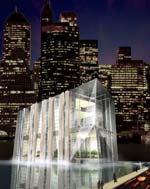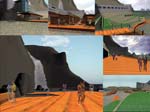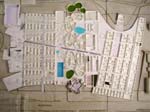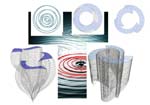

Home Site Search Contact Us Subscribe
|
|
|
|
Resort Hotels of the Future: Students' Winning Designs Shine
by ArchNewsNow.com July 5, 2006 The international design competition, “Hospitality Transformed: Resort Hotels in 2055,” invited architecture students to investigate what the future holds for hospitality design in the age of advanced technology and customized consumer experiences. Winning concepts from students around the world ranged from environmentally sensitive resorts in pristine remote locations to highly sophisticated technological wonders in dense urban settings.
From among the 500 architecture students registered for the competition – representing 84 universities in 24 countries – the jurors selected seven for recognition and cash prizes. In addition, the first and second place winners will be offered internships at a Wimberly Allison Tong & Goo (WATG) office in Honolulu, Newport Beach, Orlando, Seattle, or London.
Winners and their faculty sponsors will receive cash prizes totaling $17,000, including an award of $2,000 for best submission created using Autodesk® Revit® Building, design and documentation software for building information modeling (BIM).
The competition jury included: Bernardo Gomez-Pimienta, dean at Universidad Anahuac, Escuela de Architectura, in Mexico City; Elena Manferdini, principal of Atelier Manferdini, a California-based interdisciplinary design firm; Ron Van Pelt, WATG senior vice president; Thomas Davis Jr., senior vice president of architecture and construction for Marriott Vacation Club International and Ritz-Carlton Club; and Jim Balding, an architect with WATG and co-author of the book, "Introducing and Implementing Autodesk Revit."The program was made possible through the sponsorship of Wimberly Allison Tong & Goo, Autodesk, and Marriott Vacation Club International. The competition was administered by the Association of Collegiate Schools of Architecture.
First PlaceStudent: Sean Clark Harry, University of Cincinnati Faculty Sponsor: Michael McInturf Project: CORE (Co)rporate (R)esort (E)xperience
Student’s Design Solution: “This project seeks to develop a synthesis between current architectural kinematics and aspects of emerging technologies to create responsive building systems. This is a hotel in which surfaces and structures move according to the way humans do, capable of adapting to changing needs and technology.”
Juror’s Comments: "This entry won by proposing innovative new technologies, understanding that buildings can and should have the flexibility to adjust to market demands, and by creating a design that is attractive, innovative and realistic for 2055." — Tom Davis, Marriott Vacation Club International and Ritz-Carlton Club
Second PlaceStudents: Lionel Leow & Yanling Tay, Delft University of Technology, Netherlands Faculty Sponsor: Nanne Govert De Ru Project: Hotel Archipelago
Students’ Design Solution “In 2055, 80% of the planet’s inhabitants will live in the heart of urban cities. With such a vast number of the world’s population living and working in the polluted cores of their nations, it will be difficult to find any remaining precious pieces of nature. Therefore, the ideal hotel condenses and infuses the ancient luxuries associated with nature into a single spot, right in the heart of the city.”
Juror’s Comments “This interesting approach contrasts and combines the ideal resort hotel within a modern urban setting. This entrant suggests that future travelers will not have the time to go to a remote destination resort. So why not bring the resort to the city within the physical constraints of an urban site?” — Ron Van Pelt, WATG Best Autodesk® Revit® Building WinnerStudent: Heehyun Nam, University of Illinois at Urbana-Champaign Faculty Sponsor: Osman Ataman Project Title: Resort Hotel in Antarctica, 2055
Student’s Design Solution “This resort hotel, located in Antarctica, will educate people about the need for environmental preservation by showcasing the most preserved natural setting on earth. The hotel structure will be a self-sustaining building utilizing available and renewable resources such as water and wind.”
Juror’s Comments “The student used Revit® to create and express the design in three dimensions, incorporating custom content, complex forms, and well-organized files. Overall, a strong design executed quite professionally.” — Jim Balding, WATG
Honorable MentionStudent: Ryan Dick, University of Illinois at Urbana-Champaign Faculty Sponsor: Kevin Hinders Project: Vu’ng Nu’oc Hotel
Student’s Design Solution “Located 3.5 miles off the coast of Halong City in Vietnam, the destination is without existing infrastructure, so the hotel is designed to generate its own water and power by excavating the site to act as a dam. Timeshare owners are treated to luxury houseboats that allow guests to explore the bay. When the boats are docked at the hotel, they are plugged into the hotel’s energy and water systems and are fueled by the dam.”
Juror’s Comments "The Vu'ng Nu'oc Hotel is both creative and realistic for 2055 due to its focus on sustainability. As resort destinations around the world become more and more congested, remote islands like this one will become sites for future development. Self contained and sustainable infrastructure – including power generation, communications, desalination, effluent treatment and even food production – will become increasingly important." — Tom Davis, Marriott Vacation Club International and Ritz-Carlton Club Honorable MentionStudent: Michael Ward, University of North Carolina at Charlotte Faculty Sponsor: Dr. Jose Gamez Project: Warm:Tech
Student’s Design Solution “The premise of Warm:Tech infuses the basic qualities of comfort with advanced technological systems that will become the center of hospitality in the future. Physical environments will be altered and rearranged based on the guest’s desired interaction with the room. Atmospheric lighting will be created, cycled, and customized by occupants’ preferences, transforming the room into a reactive and dynamic environment.”
Juror’s Comments “A great presentation that illustrates the entrant's basic premise that guests will want to modify their own environments and that technology will enable them to do so.” — Ron Van Pelt, WATG
Honorable MentionStudents: David Mulder & Max Cohen De Lara, Delft University of Technology, Netherlands Faculty Sponsor: Deborah Hauptmann Project: The Continuous Interior
Students’ Design Solution “In the future, people will have no need to go outside. Taxis, airports, theme parks, offices, restaurants, airplanes, cafes, and apartments will meld into an extensive Continuous Interior. This solution is a reflection of this in the hospitality realm.”
Juror’s Comments “These students carefully analyzed and addressed the problem of the generic repetition of rooms in contemporary hotels. The proposal is a thoughtful critique of current hotel typologies and is a forecast of the trend toward artificial environments.” — Elena Manferdini, Atelier Manferdini
Honorable MentionStudents: Hyun-Jung Jang, Jung-Ah Oh, & Yoon-Kyung Lee, School of The Art Institute of Chicago Faculty Sponsors: Bruce Tharp & Carl Ray Miller Project: Argosium
Students’ Design Solution “We all come from water. The amniotic fluid in the womb acts as the body’s transportation system and carries nutrients through the blood to the baby. This future hotel will act as the womb surrounded by water. The hotel will be composed of two different parts – the flying room that brings people to the hotel and returns them back home – and the main structure.”
Juror’s Comments “An interesting concept and idea that a hotel floating in the ocean can provide for a unique and futuristic experience. It’s a very elegant, sculptural and aesthetically pleasing solution, as well.” — Bernardo Gomez-Pimienta, Dean, Universidad Anahuac, Escuela de Architectura, Mexico City
WATG’s senior vice president Howard J. Wolff, credited with initiating and conceiving this international competition, observed: “The students tackled some tough issues like sustainable design and urban revitalization without losing sight of the guest experience and the human desire for personalization and customization. I was impressed with the students’ ability to envision technology that has yet to be invented.”
Wimberly Allison Tong & Goo (WATG) is a leading architecture firm specializing in hotel and resort planning and design. Since its founding in 1945, WATG has completed work in over 150 countries on six continents from its offices in Newport Beach, Honolulu, Orlando, Seattle, London, and Singapore.
Autodesk has invested in people, software, and technology for 23 years. Autodesk® Revit® Building, the architectural design and documentation system recommended for this competition, is a leading building information modeling software.
Marriott Vacation Club International (MVCI) is a recognized leader in the vacation ownership industry. There are more than 40 MVCI resorts in the United States, the Caribbean, Europe, and Asia.
Association of Collegiate Schools of Architecture (ACSA) is a non-profit organization founded in 1912 to enhance the quality of architectural education. Membership in ACSA has grown to over 200 schools worldwide, with a membership of more than 4,500 architecture faculty.
|
(click on pictures to enlarge)  (Sean Clark Harry) First Place: CORE (Co)rporate (R)esort (E)xperience by Sean Clark Harry, University of Cincinnati (Lionel Leow/Yanling Tay) Second Place: Hotel Archipelago by Lionel Leow & Yanling Tay, Delft University of Technology, Netherlands (Heehyun Nam) Best Autodesk® Revit® Building Winner: Resort Hotel in Antarctica, 2055 by Heehyun Nam, University of Illinois at Urbana-Champaign (Ryan Dick) Honorable Mention: Vu’ng Nu’oc Hotel, Vietname by Ryan Dick, University of Illinois at Urbana-Champaign (Michael Ward) Honorable Mention: Warm:Tech by Michael Ward, University of North Carolina at Charlotte (David Mulder/Max Cohen De Lara) Honorable Mention: The Continuous Interior by David Mulder & Max Cohen De Lara, Delft University of Technology, Netherlands (Hyun-Jung Jang/Jung-Ah Oh/Yoon-Kyung Lee) Honorable Mention: Argosium by Hyun-Jung Jang, Jung-Ah Oh, & Yoon-Kyung Lee, School of The Art Institute of Chicago |
© 2006 ArchNewsNow.com